Do you struggle to come up with new content ideas?
If so, you’re not alone.
Finding fresh, engaging, and original content ideas is one of the biggest challenges faced by newcomers in the online business world. Trust me, we’ve all been there, staring at that blank screen, waiting for the muse to strike… only to hear crickets.
But what if I told you that there’s a proven system for consistently coming up with unique content ideas? Ideas that not only fill up your content calendar but also drive traffic, engagement, and, ultimately, conversions?
Well, guess what: There is. And in this guide, I’m going to break it down for you, step by step.
We’ll cover everything from leveraging user-generated content and customer feedback, to mining platforms like Quora and Reddit for inspiration, and doing gap analysis to see what topics your competitors are covering that you are not. We’ll also show you how to use Buzzsumo’s specialized tools to get endless new content ideas.
So whether you’re starting your first blog, launching an e-commerce site, or stepping into the world of affiliate marketing, this guide is for you.
Ready to kickstart your content journey? Let’s dive right in!
Why A Steady Stream of New Content Ideas Is Crucial
Keeping the content wheel turning with fresh ideas is absolutely critical in the digital world, and here’s why.
Stay Relevant
New content ideas help you stay on top of trends, ensuring that your business remains relevant in the constantly evolving digital landscape. Staying current means you can connect with your audience on topics they care about right now, and that’s key to building a loyal audience.
Engage Your Audience
It’s no secret that the internet is a crowded place, and attention spans are shorter than ever. By continuously offering fresh, exciting content, you’re more likely to grab your audience’s attention and keep them engaged. It’s about giving them a reason to keep coming back to your site or platform.
Improve SEO Ranking
Search engines **** fresh, quality content. Regularly updating your site with new ideas and unique content signals to search engines that your site is active and offers value, which can help improve your visibility in search engine results.
Establish Authority
Being a constant source of new, insightful content can help establish you as an authority in your field. The more quality content you produce, the more you demonstrate your expertise and the more trust you build with your audience.
Drive More Traffic
Every new piece of content you produce is a new opportunity to be found online, whether it’s through organic search, social media shares, or links from other sites. More content equals more visibility and, ultimately, more traffic to your site.
Content Velocity and SEO
Another reason why it’s important for content marketers to come up with a steady stream of new content ideas is content velocity.
- Content velocity is the amount of content a brand is putting out during a defined period of time. It is important for content marketers. It can play a role in search engine optimization (SEO) for several reasons.
- Search engines, including Google, often favor fresh, up-to-**** content. Websites that regularly publish new content may be seen as more relevant or reliable, and this can potentially improve their rankings.
- Regularly publishing new content gives you more opportunities to target a wider range of keywords relevant to your audience. This can help to attract more organic traffic from different search queries.
- High-quality, regularly updated content is more likely to earn backlinks from other websites. Backlinks are a crucial factor in SEO, as they’re a signal to search engines that your content is valuable and trustworthy.
- By regularly publishing new content, you can encourage search engine bots to crawl and index your website more frequently, increasing the likelihood that your latest content will show up in search results.
It’s important to note, however, that while content velocity can contribute to SEO, it’s just one of many factors search engines consider. Also, quality should never be sacrificed for quantity or speed—publishing poor-quality content just to increase content velocity can be detrimental to your SEO efforts, as it could lead to increased bounce rates, decreased time on site, and fewer backlinks.
Why It Can Be Hard To Come Up With New Content Ideas
If you’ve ever tried to keep the content machine churning, you know it’s not a walk in the park. There’s a whole heap of challenges along the way.
Creativity requires energy and inspiration. Like any other activity, you can get worn out through repetition. Eventually, you wake up one day and find that the well of inspiration you’ve been drawing on has simply dried up!
Here are some of the challenges that content marketers face in trying to come up with a constant stream of fresh and engaging content ideas:
- Saturation of Information: In the age of the internet, almost every topic under the sun has been written about. This makes it difficult to find unique ideas that haven’t been covered before.
- Maintaining Quality: Striking a balance between quality and quantity can be tricky. It’s not enough to just have new ideas; they also need to be of high quality to engage the audience effectively.
- Understanding the Audience: Audience interests and preferences can change over time, and keeping pace with these changes to produce relevant content is not easy.
- Creative Burnout: Creativity can be hard to sustain over long periods. Continuous pressure to come up with new ideas can lead to creative burnout.
- Resource Constraints: Depending on the size of your team and the resources available, it may be difficult to produce new and valuable content consistently. Researching, writing, editing, and promoting quality content all require time and effort.
- Changing Trends: Trends on the internet can change quickly. What’s popular and engaging today may not be the same tomorrow, and keeping up with these shifts can be challenging.
- SEO Requirements: Writing for SEO adds another layer of complexity. Not only does the content have to be engaging and original, but it also has to be optimized for search engines, which involves keyword research, linking strategies, and staying updated with changes in search engine algorithms.
- Lack of a Content Ideation Strategy: Perhaps the biggest factor preventing businesses from coming up with a steady stream f new content ideas is simply the lack of a content strategy. When you don’t have a system in place for generating new content ideas, it’s inevitable that creating new content eventually grinds to a halt.
Overcoming these challenges requires a solid content strategy, an understanding of your audience, and the ability to adapt to changing trends and SEO requirements.
So yes, coming up with fresh content ideas consistently is a bit of a challenge, but remember, it’s not about being perfect. It’s about learning, growing, and continuously adapting.
In this guide, you will learn some proven and practical ways to find and create content that your audience will **** and that will help you achieve your goals. We’ll dig deep and unpack strategies, tools, and techniques that can spark your creativity, keeping your content calendar bustling with original and engaging ideas.
Whether you need content ideas for blog posts, videos, podcasts, infographics, or any other format, this guide will help you discover them.
Fifteen Great Ways to Get New Content Ideas
#1. Google Auto Suggest (aka ‘alphabet soup’)
This is one of my favorite techniques, and it doesn’t cost a thing!
Just go to Google Search and type in your main keyword followed by a space and then the letter ‘a’.
For example, if your main keyword is ‘golf clubs’, this is what you do:

There are a couple of new content ideas there.
Now repeat but with the letter ‘b’:

That gives you four or five promising new content ideas.
Now do the same with the letter ‘c’:

Again, there’s a handful of potentially good content ideas that you could use as the basis for a new article or video.
#2. LowFruits Topics
LowFruits is a pay-as-you-go keyword research tool that uses Google Auto Suggest to uncover low-competition keywords.
Log into LowFruits and click on the KWFinder tool in the lefthand panel. Then type your main keyword into the KWFinder tool:
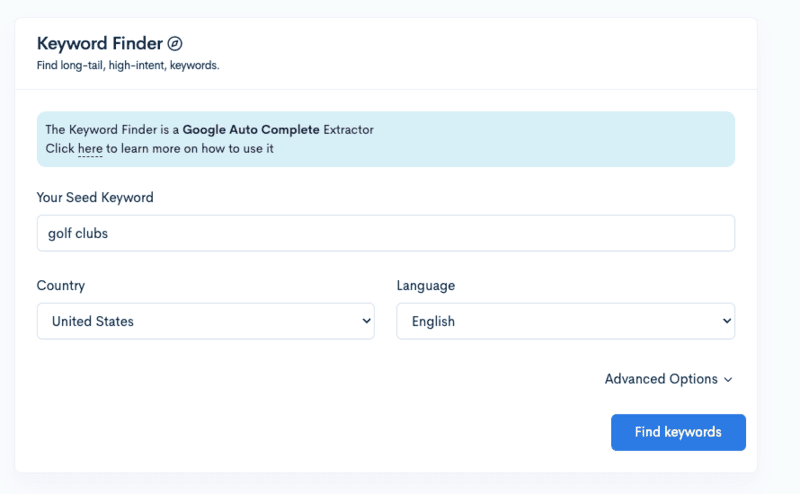
Click ‘Find Keywords’ and on the next screen click on the ‘Topics’ tab:

The keywords listed in purple are sub-topics within the topic ‘golf clubs’. They will give you some great new content ideas!
#3. LowFruits Topic Clustering Tool
This one is similar to the last technique but slightly different. Log into your LowFruits account and type your main keyword into the KWFinder tool:
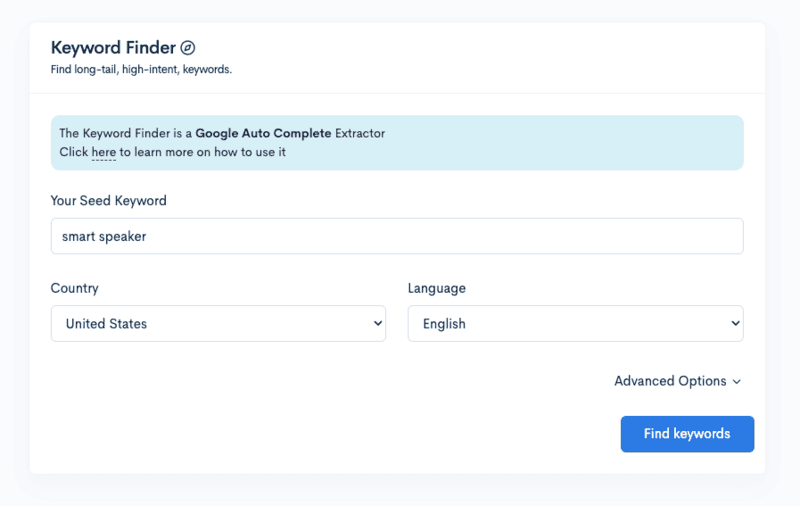
On the next screen click on the ‘Clusters’ tab and you’ll see a list of topic clusters:
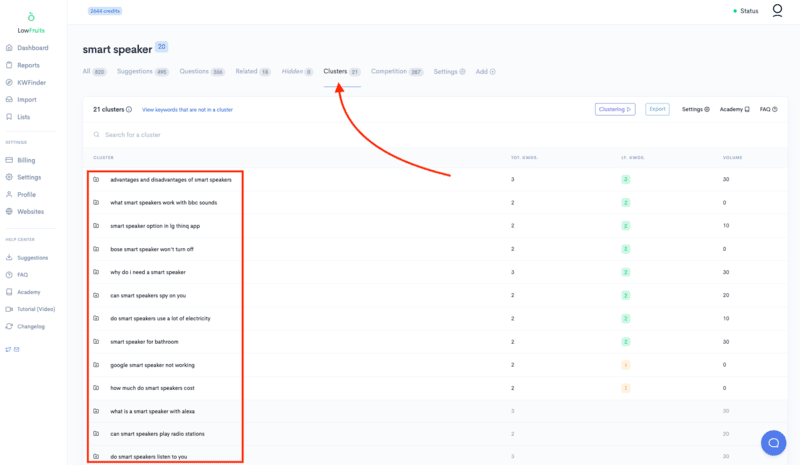
Each of these clusters is a separate topic that deserves its own article or blog post.
#4. SE Ranking Keyword Research
SERanking is an all-round SEO tool that does keyword research, tracks keyword rankings, and monitors backlinks and many other things.
Click on the Keyword Research tool, type in your main keyword, and click on the Similar Keywords Detailed Report:

On the next screen click on the ‘Similar’ tab and you’ll see a list of subtopics for your main keyword:

#5. Google Trends
Google Trends is a free tool provided by Google that allows you to see the popularity of search terms over time. It provides insights on trending topics globally or within specific regions, related queries, and comparisons between different keywords. For content creation, it’s a valuable tool for understanding what your audience is interested in and when, helping you to create timely, relevant content.
#6. SEMrush’s Topic Research Tool
SEMrush is a comprehensive SEO tool that offers features like keyword research, competitive analysis, and site audits. The tool’s ‘Topic Research’ feature can provide new content ideas based on your main keyword, showing you the top related searches, trending subtopics, and related questions being asked by users. It also allows you to see what content is performing well for competitors, which can inspire your own content strategy.
#7. Answer the Public
Answer the Public is a tool that aggregates questions that people are asking on various online platforms and forums. You enter a keyword, and it provides a wide array of questions, prepositions, and related search terms around the keyword. These can be a goldmine for content ideas as they are real questions and search terms used by people, enabling you to create content that directly addresses what your audience is searching for.
#8. Buzzsumo’s Topic Explorer
BuzzSumo is a powerful tool for getting insights and analytics related to content marketing and social media. It helps users analyze and discover popular content across various social media platforms and the web.
Buzzsumo’s ‘topic explorer’ is the perfect tool for finding related topics and important questions for any subject area.
It helps you generate ideas for blog posts, newsletters, podcasts, and other content formats by showing you popular articles, questions, and keywords related to your topic.
You can also use it to expand your reach by discovering new subject areas and keywords that your audience may be interested in.
You can access Buzzsumo’s Topic Explorer by signing up for Buzzsumo’s 30-day free trial (no credit card required).
Once logged in to your account, click on ‘Discover’ in the top menu, and then click on ‘Topic Explorer’:
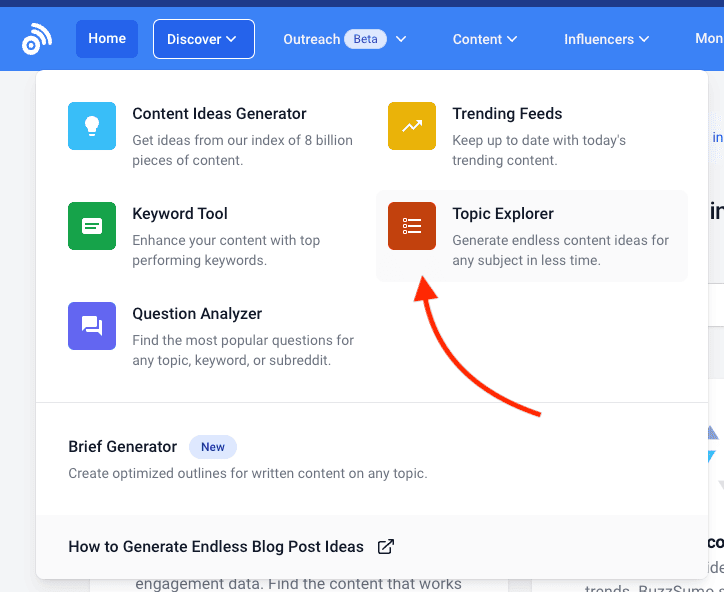
Type your main keyword into the Topic Explorer:
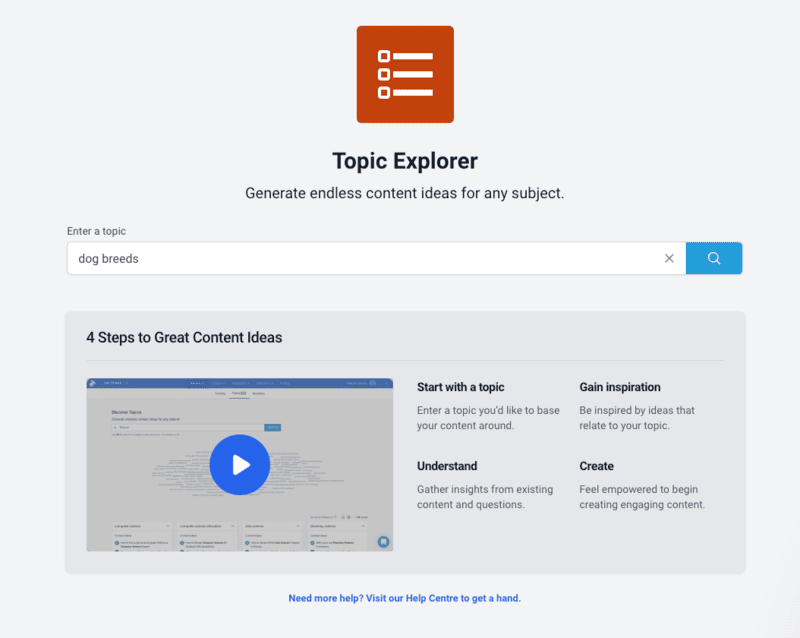
The Topic Explorer will now give you a ‘word cloud’ that shows the most popular subtopics with that topic:

Beneath the word cloud, you’ll see some ‘topic cards’. These allow you to go deeper into each individual subtopic.
Hover over the three dots on the topic card and then click on ‘Question Analyzer’:
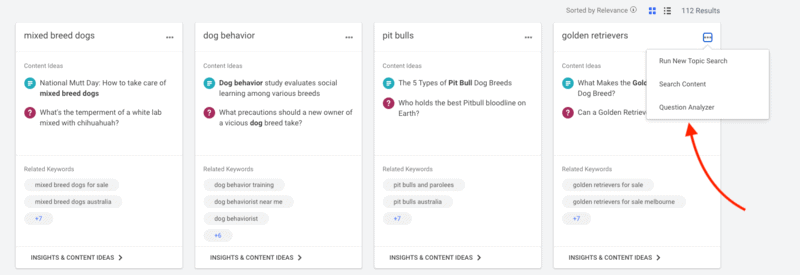
If you’re running an informational site, questions are a great way to find new content ideas!
The Question Analyzer will then list all the questions on that topic that have recently been asked (in this case there are over 8000 questions). You can pick what kind of question to focus on, based on whether the question starts with “are”, “can”, “how”, “what”, etc:

Buzzsumo is a powerful suite of tools that allows marketers and content creators to discover new, engaging content ideas based on what’s currently trending or performing well in their industry.
Here are some other ways you can use Buzzsumo to uncover new topic ideas:
Discover Popular Topics: With Buzzsumo, you can find out what content is trending or has been the most shared across social media within your industry. Simply enter relevant keywords into the search bar, and Buzzsumo will show you a list of the most shared content related to those keywords. This can give you an idea of the kind of content that resonates with your audience.
Analyze Competitor Content: Buzzsumo allows you to enter a competitor’s URL to see what their most popular content is. This can provide insight into the topics, formats, and styles that work well for them and might work for you too.
Identify Influential Content Creators: Buzzsumo’s Influencers tool can help you identify key influencers in your industry. You can see what kind of content these influencers are sharing and engaging with, which can provide further ideas for your own content.
Question Analyzer: The Question Analyzer feature allows you to see what questions people are asking on forums, Q&A sites like Quora, and other social platforms. These questions can inspire informative blog posts, FAQ pages, how-to guides, and other types of content that directly answer your audience’s needs.
Trending Now Feature: The ‘Trending Now’ section shows you the most popular content across the web in real-time. You can filter this by topic and location to find trends that are relevant to your audience.
Content Alerts: Set up alerts for certain keywords or topics related to your industry. Buzzsumo will notify you when new content around these topics starts trending, giving you the opportunity to stay on top of current discussions and respond with timely content.
Monitor Keywords and Brands: With Buzzsumo, you can set up alerts for specific keywords and brands. This means you’ll be notified whenever there’s a significant social conversation or a new piece of content related to these terms.
#9. Engage with social media trends
Harnessing the power of social media is a great way to keep your content ideas fresh, timely, and relevant. Here’s how you can do it:
Monitor Trending Topics: Most social platforms have a feature that shows trending topics or popular hashtags. These are real-time insights into what people are talking about right now. It’s a goldmine for content creators, as it can inspire content that is timely and in line with what your audience is interested in at the moment.
Follow Industry Influencers: Influencers in your niche are often at the forefront of industry trends. Keeping an eye on their content can help you spot new topics, questions, or trends that you can incorporate into your own content.
Use Social Listening Tools: There are several social media monitoring tools that can help you track conversations and topics relevant to your niche across different social platforms. These tools can help you understand what your target audience is discussing, questioning, or showing interest in.
Engage With Your Audience: Don’t just monitor your audience – engage with them! Ask questions, start conversations, and pay attention to the responses. The comments and discussions can reveal what your audience is curious about or struggling with, providing you with great content ideas.
Keep An Eye On Competitors: What topics are your competitors covering on their social channels? Is their audience responding well to a particular type of content? While you shouldn’t copy their ideas, you can use this information to inspire your own unique take on these subjects.
Remember, the aim is not to jump on every trend but to identify the ones that align with your brand and your audience’s interests. Using social media trends in this way allows you to create content that resonates, engages, and ultimately, drives results.
#10. Conduct audience surveys
Another way to generate new content ideas is to tap into the needs of your audience. Understanding audience needs can be a goldmine for new content ideas. Here are some of the benefits of better understanding your audience:
- Relevance: Knowing your audience’s interests, questions, and pain points helps you create content that is directly relevant to them. Relevant content is more likely to attract and retain audience attention and engagement.
- Value: When you understand what your audience needs, you can provide value by answering their questions, providing solutions to their problems, or sharing insights that they find interesting or useful.
- Trust and Loyalty: Content that consistently meets your audience’s needs can build trust and loyalty, turning casual visitors into repeat audience members, subscribers, or customers.
- SEO Performance: Search engines aim to provide users with the most relevant and high-quality content for their search queries. If you understand and meet your audience’s needs, your content is more likely to rank higher in search results.
- Conversion: Content that is tailored to audience needs is more likely to lead to conversions, whether that means newsletter sign-ups, content shares, product purchases, or any other actions that you want your audience to take.
- Competitive Advantage: If you understand your audience better than your competitors do, you have an advantage. You can create content that more effectively meets your audience’s needs and differentiates you from your competitors.
- Audience Growth: High-quality, relevant content is more likely to be shared, helping you reach new audience members.
In short, understanding audience needs ensures that your content efforts are not wasted on topics that your audience finds irrelevant or uninteresting. Instead, every piece of content you create has the potential to engage your audience, meet your business goals, and contribute to your success.
TOOLS FOR DOING AUDIENCE SURVEYS
Here are some popular audience survey tools:
#11. Conduct competitor analysis
Competitor content analysis plays a crucial role in content creation and marketing strategy.
Peering into your competitors’ content is a bit like detective work – you’re searching for clues that’ll help crack the code of your own success. So, let’s put on our Sherlock Holmes hats and dive in!
In this kind of competitor analysis, we’re mainly looking for gaps. What are the topics that your competitors have covered but that you haven’t? These are great new content ideas for your website, your YouTube channel, or your social media accounts.
How To Do Competitor Analysis in SE Ranking
SE Ranking is an all-in-one SEO software that includes a powerful suite of tools for competitor analysis. Beyond providing insights into your competitors’ SEO strategies, it can also be a rich source of new content ideas.
Here’s how to use SE Ranking for content ideation.
Start by entering your own domain into the Competitor Research tool, and then click ‘Analyze’.
Then choose two competitors from the list of competitor websites.
Next, click on ‘Competitor Comparison’ in the lefthand panel, enter the domains for your two competitors, and click ‘Show Results’:

On the next screen, click on the ‘Missing’ tab. These are keywords that your two competitors rank for in the top 100 search results but you don’t. In this example, there are over 183,000 keywords that my website is missing – that’s a lot of new content ideas!
You can order the list by keyword difficulties and search volume:

You can also use SE Ranking to see which pages are driving most of your competitors’ traffic – that’s another great source of new content ideas.
Backlink Analysis: The Backlink Monitoring tool will let you see not just who is linking to your competitors, but also which specific pages they’re linking to. High numbers of backlinks might indicate a piece of content that’s particularly valuable or unique. Explore these pages for inspiration.
Paid Ads Analysis: If your competitors are running paid campaigns, you can use SE Ranking to see the keywords and ads they’re using. This can reveal popular topics and phrases that you could consider addressing in your own content.
Monitor Changes Over Time: Regularly use SE Ranking to monitor changes in your competitors’ keyword rankings, backlinks, and popular pages. Shifts in these areas could indicate new content initiatives or shifts in strategy, providing you with ongoing content ideas.
Analyze Social Media Popularity: SE Ranking also shows the social media popularity of your competitor’s website pages. This can give you an idea of what content formats and topics are more likely to be shared on social media.
#12. Mine Reddit for New Content Ideas
Reddit, often called “The Front Page of the Internet”, is a fantastic resource for finding new content ideas due to its rich and diverse community-driven content. Here’s how you can use Reddit to spark content ideas:
- Identify Relevant Subreddits: Reddit is made up of thousands of ‘subreddits’, which are individual communities centered around specific topics. Start by identifying subreddits that align with your industry, niche, or target audience’s interests. For example, if your content revolves around digital marketing, subreddits like r/marketing, r/SEO, or r/content_marketing could be beneficial.
- Monitor Trending Topics: Once you’ve identified relevant subreddits, monitor them regularly for trending topics. These are discussions or posts that are getting a lot of upvotes or comments, indicating high user interest. Trending topics can serve as inspiration for your own content.
- Understand Audience Pain Points: Pay attention to the questions or challenges users post about. These pain points can inspire ‘how-to’ guides, tutorials, or other educational content aimed at addressing these issues.
- Monitor AMAs (Ask Me Anything): AMAs are sessions where users can ask questions to the host about their field of expertise. They often provide a wealth of insights into topics your audience is interested in. You can use these insights to create content that provides the answers they’re seeking.
- Direct Engagement: Don’t just be a silent observer. Engage with the community, answer questions, participate in discussions, and even pose your own questions. This can provide direct insights into what your target audience is interested in.
- Keyword Research: Use Reddit for keyword research. See what phrases or words are frequently used in discussions related to your niche. These can potentially be valuable keywords to target in your content.
Remember, Reddit is a community-driven platform. Always respect the rules of each subreddit, and strive to add value to the community with your engagement. This will give you the best insights and also build a positive reputation for your brand on the platform.
#13. Leverage Quora for Content Ideation
Quora is an excellent platform for uncovering fresh content ideas. As a Q&A website, it provides direct insights into the questions, interests, and discussions that are engaging your target audience. Here’s how to use Quora for content ideation:
- Follow Relevant Topics: Start by identifying and following topics relevant to your industry or area of interest. This will provide a feed of questions and discussions related to these topics.
- Identify Common Questions: Look for questions that come up repeatedly. These reflect the common queries, concerns, or interests of your audience, and can be used as inspiration for blog posts, guides, videos, or social media content.
- Explore ‘Related Questions’: Quora will often suggest related questions on the right side of the page. These can offer further ideas for content or help you uncover subtopics you might not have considered.
- Monitor Questions and Answers: Regularly check the latest questions and most upvoted answers in your chosen topics. Pay attention to the kinds of questions being asked and the issues or challenges users are discussing. These can serve as inspiration for blog posts, infographics, videos, or other types of content.
- Understand Audience Pain Points: Look for questions that highlight problems or challenges your audience is facing. These pain points can form the basis of ‘how-to’ guides, tutorials, or explainer videos. If a lot of people are asking the same question, it’s a good indication there’s a need for content that addresses that issue.
- Engage with the Community: Don’t just observe – engage with the community by asking and answering questions. The interactions and feedback you get can help refine your understanding of your audience and stimulate further content ideas.
- Look at the ‘Most Viewed Writers’: Under each topic, you can find a list of the ‘Most Viewed Writers’. Check out the questions they’ve answered as they are likely addressing the most popular and relevant topics in your industry.
- Use Quora’s Search Function for Keyword Research: You can use Quora’s search function to discover which questions and topics are most popular. Enter keywords related to your niche and see what questions come up. The phrases and terms used in these questions can help guide your keyword strategy.
- Turn Questions into Content Ideas: Finally, turn the questions you find on Quora into content ideas. For example, a question like “What is the best way to improve SEO for a small business?” could inspire a blog post titled “10 Effective SEO Strategies for Small Businesses”.
#14. Harness Customer Feedback for Content Ideation
Customer feedback is a goldmine for content ideas. It offers direct insight into your customers’ experiences, needs, challenges, and interests. Here’s how you can use customer feedback for content ideation:
- Surveys and Questionnaires: Conduct regular surveys or questionnaires to gauge your customers’ interests, needs, and challenges. The responses can help you identify common problems or questions that your content could address.
- Customer Service Interactions: Pay close attention to the questions and concerns customers raise through your customer service channels. These can often suggest practical, helpful content like FAQs, how-to guides, troubleshooting advice, or product usage tips.
- Product Reviews: Positive reviews can highlight what customers **** about your product or service, suggesting content that emphasizes these strengths. Negative reviews, on the other hand, can pinpoint areas of confusion or dissatisfaction, suggesting content that clarifies, educates, or reassures.
- Social Media Feedback: Monitor the comments, mentions, and direct messages you receive on social media. These can often reveal what customers are currently interested in or curious about, suggesting timely and engaging content ideas.
- User Forums or Community Platforms: If you have a user forum or community platform, pay attention to the discussions there. They can reveal common themes or issues that your content could address.
- Net Promoter Score (NPS) Feedback: The open-ended feedback provided by promoters, passives, and detractors during an NPS survey can offer valuable insights into what customers value or want more information about.
#15. Get Ideas from UGC
User-generated content (UGC) — content created and shared by your customers or fans — is a rich source of inspiration for your own content efforts. It reflects what your audience finds engaging, relevant, and shareable about your brand. Here’s how to use UGC for content ideation:
- Social Media Interactions: Monitor the content your audience shares or tags you in on social media platforms. This could include photos of your products, reviews, stories about their experience with your brand, or even memes. Each of these can inspire a range of content ideas, from case studies to user guides, to feature updates.
- Community Forums and Discussions: If you have an online community forum, or if your brand is often discussed on platforms like Reddit or Quora, these conversations can suggest new content ideas. Look for common questions, debates, or shared experiences that your content could address.
- Review Analysis: Look at what customers are saying about you in their reviews. Their insights can inspire a range of content, from blog posts addressing common questions or concerns, to ‘how-to’ videos showing how to make the most of your product or service.
- UGC Contests or Campaigns: Encourage UGC through contests or campaigns, asking your audience to share their experiences, ideas, or creative uses of your product. This not only generates more UGC for inspiration but can also provide direct content for your channels.
- Testimonials and Case Studies: Happy customers sharing their positive experiences and success stories can inspire testimonials and case studies. These can be powerful forms of content that build trust and provide real-life examples of your product or service in action.
Remember, when using UGC in your content, it’s important to always get permission from the original creators. Respecting and acknowledging your community’s contributions is key to maintaining a positive relationship with your audience.
Conclusion
Generating new content ideas is a challenging yet essential aspect of maintaining a successful and engaging online presence. We explored the reasons why individuals and businesses often struggle with this task, and we looked at why it’s vital to constantly refresh your content to keep up with the fast-paced digital landscape.
Understanding the importance of new content ideas is fundamental in the era of content velocity, where the volume and speed of information dissemination can greatly impact your visibility and reach. Stagnation is no longer an option; innovation and creativity are now the driving forces behind online success.
Throughout this article, we discussed several proven methods for generating fresh content ideas. Leveraging SEO tools, like Buzzsumo, can uncover valuable insights into popular trends and topics, guiding content ideation in the right direction. We also looked at social media trends as another powerful source of new content ideas.
Engaging in audience surveys can bridge the gap between content creators and consumers, providing invaluable feedback that can spark novel and tailored content ideas. Additionally, competitor analysis will show you topics that your competitors have covered that you have not.
We also looked at some innovative approaches to content idea generation, in particular Reddit and Quora. By actively mining user-generated content (UGC) and harnessing customer feedback, content creators can create authentic and resonant content that directly addresses the needs and interests of their audience.
The journey to discovering fresh content ideas may be challenging, but it is an indispensable aspect of building a vibrant online presence. By harnessing the power of creativity, technology, and audience insights, you can unlock boundless possibilities and establish yourself as a dynamic, relevant, and influential content creator in a rapidly changing digital landscape.
